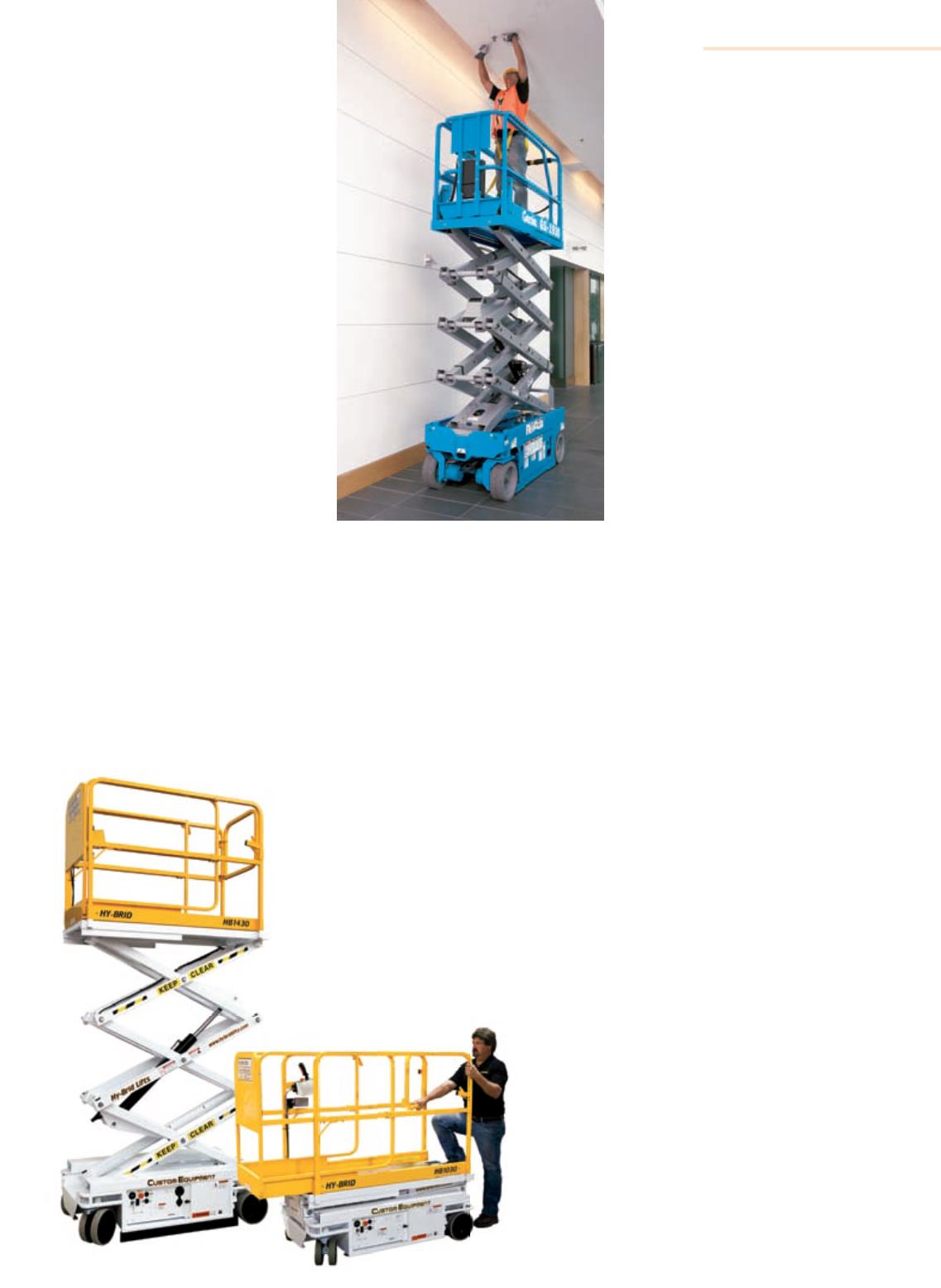
55
LOW-LEVEL ACCESS
NOVEMBER-DECEMBER 2013
ACCESS, LIFT & HANDLERS
because of their weight, they typically can’t
access work on freshly poured concrete until it
has fully cured, which could take up to 30 days
and delay projects.
Since taller, over-19-foot lifts can weigh as
much as 3,300 pounds (Terex AWP's GS-1930
weighs 2,702; MEC Aerial Work Platform's
1932ES weighs 3,060 pounds; Snorkel's 1930E
is 3,160 pounds and Skyjack's SJIII 3219 comes
in at 2,580 pounds), contractors and operators
must know floor load limits. Low-level lifts can
weigh as little as 600 pounds and some feature
dual front wheels that help disperse the weight
and wheel-load concentration. Together, those
aspects allow operators to tackle projects on
freshly poured concrete sooner and access jobs
on delicate flooring with no damage.
To further prevent damage in finished spaces,
many units - both 19-foot and below - also
feature non-marking wheels that prevent scuffs
on hard surfaces.
Some low-level lifts also are equipped with
counter-rotating wheels; while one wheel
rotates down, the other rotates up. This
motion reduces the friction point so the lift can
maneuver over carpet without causing tears.
Heed the hydraulics
Heavier lifts aren’t the only thing that can
damage floors; hydraulic systems can be a
culprit, as well. Hydraulic systems that operate
the lift’s steering, driving and lifting have more
doorways in commercial applications. However,
those with higher stowed heights can make
ducking under doorways or into elevators with
drywall or framing on board nearly impossible,
and it limits the range of work that can be
performed with the lift. Also, lifts with wider
turning radiuses might not be able to maneuver
around tight corners.
Low-level scissor lifts can be as narrow as
25 inches, and some feature stowed heights as
low as 66 inches. This provides more clearance
for getting under doorways and into elevators,
even with taller materials on board. Low-level
lifts also feature platform lengths as short as
47 inches, so they can easily fit in any elevator
in the United States that’s built to code. In
addition, some models allow operators to turn
in shorter radiuses, some as low as zero, for
easier maneuverability around tight corners and
into hallways or small offices without assistance
from other crewmembers.
A tough climb
As mentioned earlier, using low-level lifts
increases efficiency and productivity. More
important than those benefits, however,
is the impact these lifts have on worker
safety, especially when compared to ladders.
According to OSHA, falls from ladders are one
of the leading causes of occupational injuries
and fatalities. The risk is so great that some
countries have enacted strict regulations on
their usage. Users also can suffer from less
serious injuries like bruising and tenderness
on the soles of their feet from standing on a
ladder’s narrow rungs for extended periods of
time. While there are times, places, and projects
for ladders, general contracting or maintenance
jobs usually aren’t among them.
The final show
Nineteen-foot scissor lifts might take you a little
higher than low-level lifts, and they are certainly
safer than ladders. But when comparing what
really matters on a jobsite, it goes beyond
simple height capabilities.
The benefits of the thoughtful design of low-
level scissor lifts aren’t just smoke and mirrors.
Whether you’re hanging drywall, installing
sprinkler systems, painting or doing electrical
work, your lift’s features should allow you and
your employees to get all these jobs done safely
and easily. With 14- to 20-foot working heights,
low-level lifts are revealing that the “higher is
always better” perception is the real illusion.
■
The Genie GS-1930 self-propelled scissor
lift comes standard with a low-emission
electric drive that delivers a quiet,
convenient method for operation in sound-
sensitive environments. The units’ narrow
profile, 2 feet 6 inches, allows it to pass
through standard doorways, and with its
turning radius of 5 feet 1 inch, this scissor
lift is ideal for working in office buildings,
shopping malls, hotels, schools and more.
Low-level
scissor
lifts allow
users to
accomplish
general
contracting
projects at
working
heights up to
20 feet.
routing with six to eight connection points. If
these points become loose, fluid can leak and
damage carpeting, which will require costly
replacement. Not only that, but fluid that leaks
onto hard surfaces like tile or laminate creates
slip hazards. Some rough terrain and electric
scissor lifts feature hydraulic steering, driving
and lifting, which means there is an increased
risk for damage and safety incidents.
The hydraulic system on low-level lifts
typically only powers them up and down, while
battery power operates the driving and steering.
This configuration has only two connection
points, so the chance of a leak is greatly
reduced. Some low level scissor lifts even
feature a fully contained hydraulic system, so
even if a leak occurs the fluid does not escape
to damage carpeting or create hazards.
There are, of course, many options to avoid
hydrualic leaking, including equipment diapers
and other types of spill-proof solutions.
Getting around (or under)
Maneuvering between studs and walls,
around tight corners or into small spaces can
be challenging with a lift. Many are no wider
than 32 inches, well within the width of most
number


